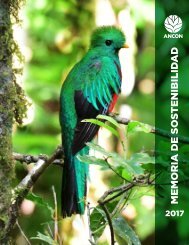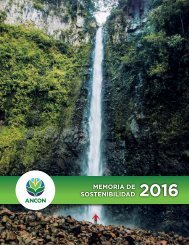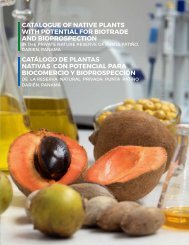Create successful ePaper yourself
Turn your PDF publications into a flip-book with our unique Google optimized e-Paper software.
24<br />
PRIVATE NATURE RESERVE OF PUNTA PATIÑO DARIEN, PANAMA<br />
RESERVA NATURAL PRIVADA PUNTA PATIÑO DARIÉN, PANAMÁ<br />
E<strong>la</strong>eis oleifera<br />
(Kunth) Cortés ex Prain<br />
Common name: Corocita<br />
Synonyms: Alfonsia oleifera, Corozo oleifera, E<strong>la</strong>eis<br />
dybowskii, E. macrophyl<strong>la</strong>, E. madagascariensis, E.<br />
me<strong>la</strong>nococca, Palma oleosa.<br />
Botanical family: Arecaceae (Palm family)<br />
Other names: Corozo colorado, corozo, palma<br />
aceitera (Pan), coquito (Nic, CR), hone (Baja<br />
Ta<strong>la</strong>manca, CR), palmiche (Nicoya Peninsu<strong>la</strong>, CR),<br />
sama, samaque (guna, Pan), American Oil Palm (Eng)<br />
Description: Low-lying tree with a trunk that bends<br />
towards the ground as the palm grows, rarely taller<br />
than five meters. White, <strong>de</strong>nsely clustered flowers.<br />
The fruits are small, 2 to 3 cm in length, with an<br />
orange to red-colored skin and little flesh. The seeds<br />
are b<strong>la</strong>ck and thick-shelled.<br />
Distribution: Present in various sectors of the <strong>Punta</strong><br />
<strong>Patiño</strong> Private Nature Reserve. Found throughout<br />
Panama in low-lying forests along the Pacific coast<br />
and in the canal region and the Guna Ya<strong>la</strong>. This<br />
species can be found from Honduras to Brazil and<br />
Peru.<br />
Phenology: Flowers from February to June, fruits<br />
appear from March to June, ripening slowly on the<br />
palm, with infructescences ripening at different<br />
speeds.<br />
Uses: This palm is wi<strong>de</strong>ly used by rural families in<br />
the country and indigenous peoples from Eastern<br />
and Western Panama. In some regions, the oil is still<br />
extracted from the fruit and the nuts for cosmetic use<br />
Nombre común: Corocita<br />
Sinónimos: Alfonsia oleifera, Corozo oleifera, E<strong>la</strong>eis<br />
dybowskii, E. macrophyl<strong>la</strong>, E. madagascariensis, E.<br />
me<strong>la</strong>nococca, Palma oleosa<br />
Familia botánica: Arecaceae (familia <strong>de</strong> <strong>la</strong>s palmas)<br />
Otros nombres: Corozo colorado, corozo, palma aceitera<br />
(Pan), coquito (Nic, CR), hone (Baja Ta<strong>la</strong>manca,<br />
CR), palmiche (Penínsu<strong>la</strong> <strong>de</strong> Nicoya, CR), sama,<br />
samaque (guna, Pan), American Oil Palm (ingl.)<br />
Descripción: Árbol <strong>de</strong> baja altura, cuyo tronco se<br />
acuesta sobre el suelo a medida que <strong>la</strong> palma crece,<br />
<strong>de</strong> manera que rara vez sobrepasa los cinco metros<br />
<strong>de</strong> altura. Las flores son b<strong>la</strong>ncas, <strong>con</strong>gestionadas en<br />
un racimo <strong>de</strong>nso. Los frutos son pequeños, <strong>de</strong> unos<br />
2 a 3 cm <strong>de</strong> <strong>la</strong>rgo, <strong>con</strong> cáscara <strong>de</strong> color naranja a rojo<br />
y poca pulpa. Las semil<strong>la</strong>s son negras, <strong>de</strong> testa muy<br />
dura.<br />
Distribución: Está presente en varios sectores <strong>de</strong> <strong>la</strong><br />
<strong>Reserva</strong> <strong>Natural</strong> <strong>Privada</strong> <strong>Punta</strong> <strong>Patiño</strong>, y en Panamá<br />
se pue<strong>de</strong> en<strong>con</strong>trar en bosques <strong>de</strong> tierras bajas <strong>de</strong> <strong>la</strong><br />
vertiente <strong>de</strong>l Pacífico, el área <strong>de</strong>l canal y Guna Ya<strong>la</strong>.<br />
La especie se distribuye <strong>de</strong>s<strong>de</strong> Honduras hasta Brasil<br />
y Perú.<br />
Fenología: Florece entre febrero y junio y los frutos<br />
aparecen entre marzo y junio, pero maduran lentamente<br />
y en <strong>la</strong> palma hay infrutescencias <strong>con</strong> distinto<br />
grado <strong>de</strong> maduración.<br />
Usos: Es una palma que era muy empleada por<br />
campesinos <strong>de</strong> varias regiones <strong>de</strong>l interior <strong>de</strong>l país y<br />
los pueblos originarios <strong>de</strong>l oeste y el este <strong>de</strong> Panamá.<br />
En algunas regiones aún extraen aceite <strong>de</strong> los frutos








